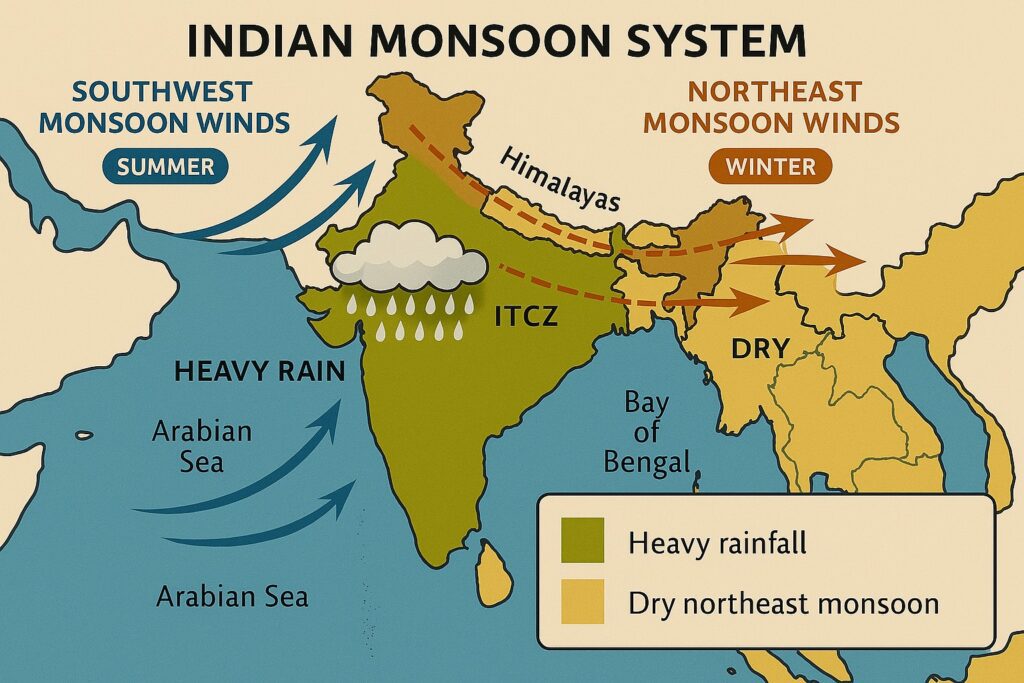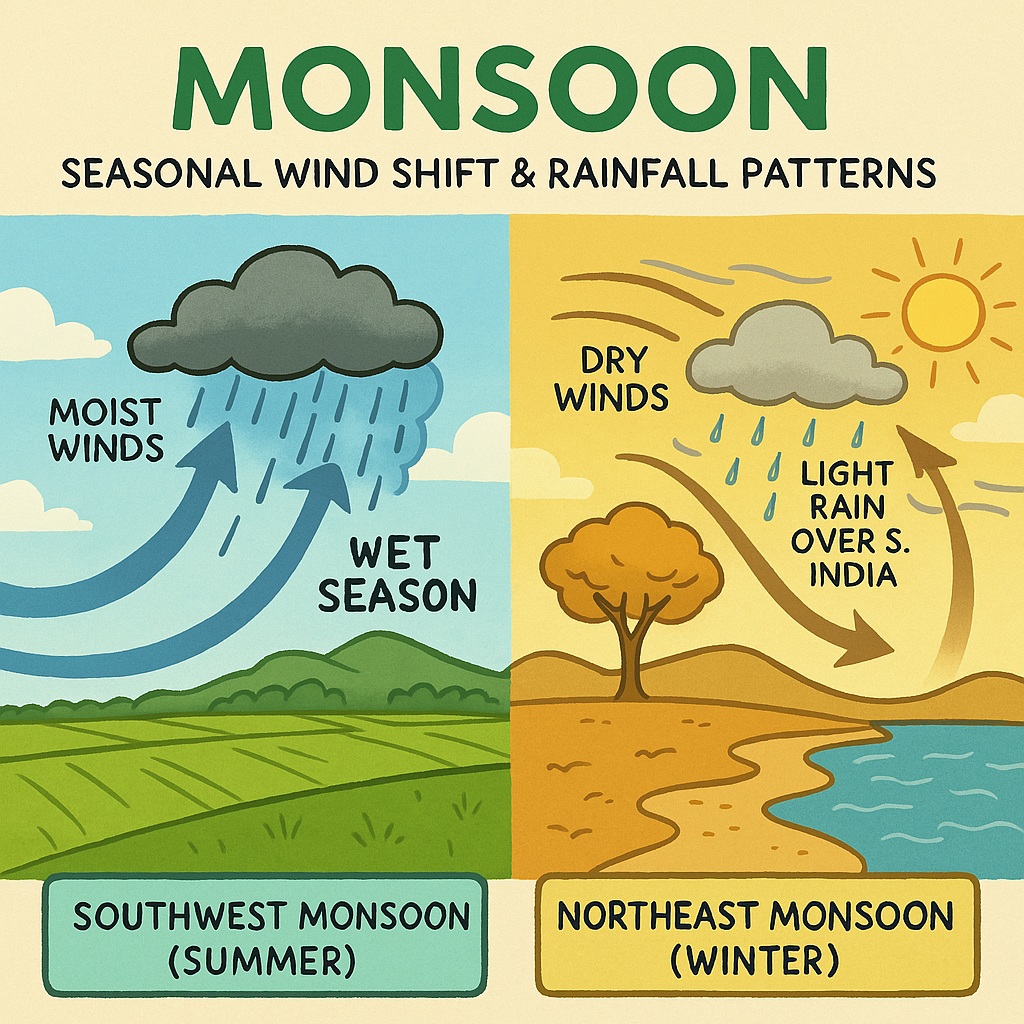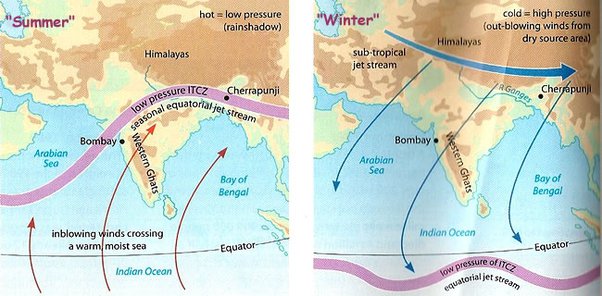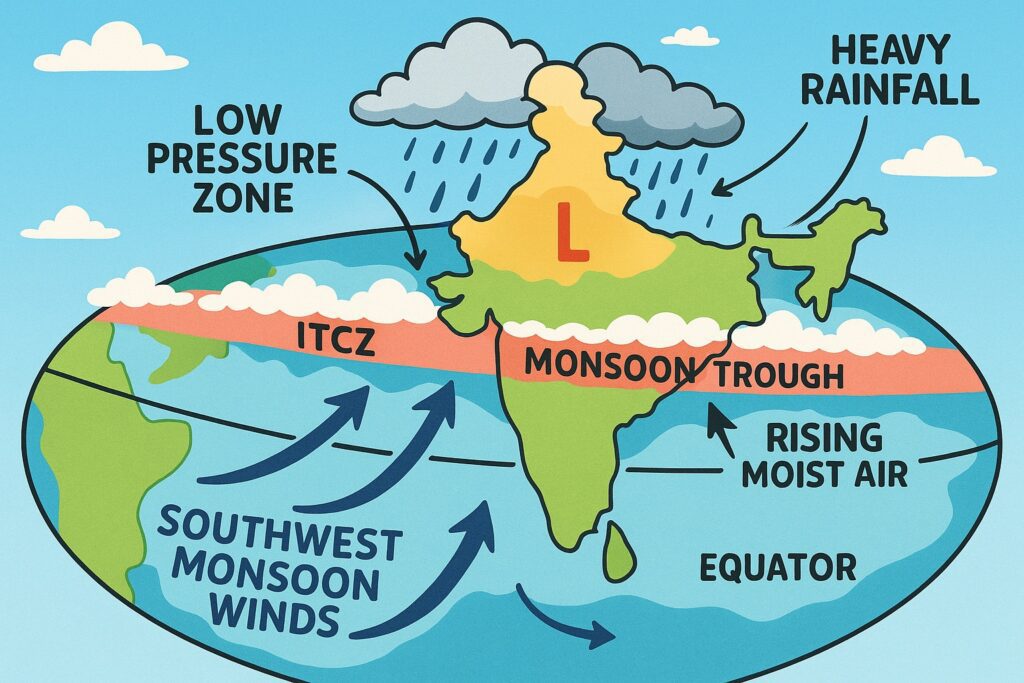A monsoon is a seasonal wind system that brings heavy rainfall to certain regions of the world. Monsoons are the result of the movement of large masses of air from land to sea, driven by differences in temperature and pressure. The term monsoon is derived from the Arabic word “mausim,“ which means season.

Table of Contents
What is Monsoon?
A monsoon is a seasonal change in wind direction that brings heavy rains to certain regions during specific times of the year. It’s like a big wind that blows differently in different seasons, bringing a lot of rain when it blows in one direction. They are evident in specific parts of world parts of the world, such as Southeast Asia, East Africa, and parts of Australia and America. There are two phases of monsoon:
-
Southwest Monsoon (Wet Season) – Summer monsoon bringing heavy rainfall.
-
Northeast Monsoon (Dry or Retreating Monsoon) – Winter monsoon causing light rain in some regions.
Mechanism of Monsoon
The origin of monsoons can be attributed to several factors related to the Earth’s atmosphere and geography.
Differential Heating
Monsoons are primarily caused by the differential heating of land and water surfaces. During the summer months, land surfaces heat up more quickly than ocean surfaces because land has a lower heat capacity than water. This temperature difference creates a region of low pressure over the landmass.
-
In summer, the Indian subcontinent heats up more quickly than the surrounding oceans.
-
This heating creates a low-pressure zone over the land and a high-pressure zone over the Indian Ocean.
-
Air always moves from high-pressure to low-pressure areas. So, the air from the high-pressure region over the ocean starts moving toward the Indian landmass.

Air Movement
As warm air rises over the heated landmass, it creates an area of low pressure. Meanwhile, cooler air from over the ocean flows towards this low-pressure area, resulting in the onset of monsoon winds. These winds bring moisture-laden air from the ocean to the land, leading to heavy rainfall.
-
As the air travels from the ocean to the land, it picks up moisture from the warm Indian Ocean and Arabian sea.
-
These winds are known as the Southwest Monsoon Winds.
-
When these moist winds hit the Western Ghats, Himalayas, or other elevated regions, the air rises, cools down, and causes heavy rainfall.
Seasonal Shift of Wind
During the summer months, winds blow from the ocean towards the land, bringing rain. In contrast, during the winter months, winds blow from the land towards the ocean, resulting in drier conditions.
In winter,
-
Land cools down faster than the ocean.
-
Now, there’s a high-pressure area over land and a low-pressure area over the ocean.
-
Cool, dry winds blow from land to sea (northeast direction).
-
These winds carry little to no moisture, so most of India remains dry.
-
However, the Tamil Nadu coast gets rainfall because these winds pick up some moisture from the Bay of Bengal.

Shifting of ITCZ
The Inter-Tropical Convergence Zone (ITCZ) is a narrow belt of low pressure that encircles the Earth near the equator. It forms due to the convergence of trade winds from both the Northern and Southern Hemispheres. This convergence causes warm, moist air to rise, resulting in cloud formation and heavy rainfall.
-
During summer, the landmass of India heats up more than the ocean, creating a low-pressure area over the northern plains.
-
The ITCZ shifts northwards, following the overhead position of the sun, and aligns roughly along the monsoon trough over the Indian subcontinent.
-
Here, the moist southwesterly monsoon winds from the Indian Ocean converge at the ITCZ.
-
This convergence forces the air to rise, cool, and condense, leading to intense rainfall, especially over central and northern India.


Jet Streams
Jet streams are fast-flowing, narrow air currents found in the upper atmosphere. They play a significant role in shaping weather patterns, including the Indian monsoon.
-
In winter, this jet stream flows over the Indian subcontinent, bringing dry, stable air.
-
In summer, the SWJ retreats northward beyond the Himalayas.
-
This northward shift creates favorable conditions for:
-
The development of a low-pressure area over northern India.
-
The inflow of warm, moist southwesterly monsoon winds from the Indian Ocean
-
Geographical Features
The geographical features of the region also influence the development of monsoons. For example, the presence of the Himalayas and other mountain ranges enhance the uplift of moist air, leading to orographic rainfall in the region.

Ocean Currents
Oceanic currents play an important role in regulating global climate, including the Indian monsoon system. They influence sea surface temperatures, which in turn affect the temperature and moisture content of the winds that reach the Indian subcontinent.
-
Warm currents like the North Equatorial Current and Mozambique Current raise sea surface temperatures in the Indian Ocean.
-
This leads to increased evaporation and higher moisture content in the air.
-
As the southwest monsoon winds blow over these warm waters, they pick up more moisture, resulting in heavier rainfall over India.
Impacts of Monsoons
Agriculture
Monsoons play a crucial role in agriculture, bringing the rainfall necessary for crops to grow and supporting the livelihoods of millions of people. In regions where monsoons are a dominant feature of the climate, crops are often timed to coincide with the monsoon season, maximizing the chances of a good harvest.
Economy
Monsoons also play a critical role in the economy of the regions they affect. In countries such as India, the monsoon season can be a key driver of economic growth, with increased rainfall leading to higher crop yields and improved agricultural productivity.
Disasters
While monsoons can bring much-needed rainfall to certain regions, they can also bring significant risk and danger. Heavy rainfall and strong winds can cause severe flooding and landslides, leading to significant loss of life and property damage.
In some regions, such as Bangladesh, monsoons can also bring high levels of water-borne disease, as stagnant water provides an ideal breeding ground for mosquitoes and other disease-carrying insects.